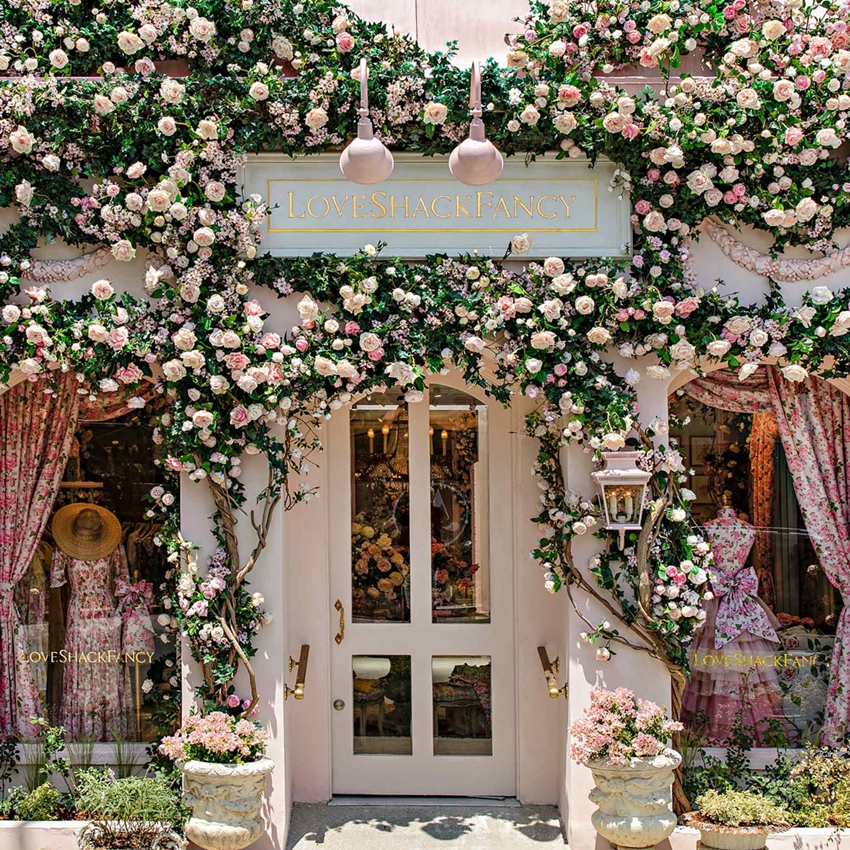Much like the cottagecore trend that came onto the radar a few years ago, LoveShackFancy is selling more than just a frilly pink dress –– they’re selling a paradigm. They’re hawking a paradigm of a traditional idyllic femininity experience that’s reminiscent of the Victorian era ideal of the “angel of the house” role that women played in England in the 1900s. The clothing is straight from “A Midsummer Night’s Dream,” but with much more liberal use of hot pink and ruffles.
LoveShackFancy falls into the entry-level luxury category. The website’s blog is called “Storybook,” and it has pictures of model-esque young women flouncing around at parties around the world wearing long, ruffled dresses. For customers for whom the apparel alone is not enough to express their femininity, LoveShackFancy recently released a home line that’s complete with flowery bedding sets, as well as home accessories like hand-painted tablecloths and $195 linen napkins.
LoveShackFancy fans aren’t adhering to the strict age limits that society once put on overtly feminine clothing. These women are willing to spend $500 bucks a pop to wear a dress they really like –– lace, ruffles, supersize bows and all. Traditional expressions of femininity can be just as feminist as a cutoff band tee and “Eat the Rich” earrings.
Teen and tweens with their parents’ money to burn go crazy for LoveShackFancy dresses. The looks were dubbed “the reverse Kardashian” by Jill Kargman, a critic who used (anti-feminist) language like “whore” and “skanky” to describe the edgy looks that came before LoveShackFancy in the Wall Street Journal.
Maximalism at Play for a Different Demographic
When you think about the word “maximalism,” do you think about neon brights and barely-there miniskirts? Sort of a 90s club kid wearing modern fabrics and cuts? Because that’s only one of the many interpretations of the term. Maximalism in fashion can be simply defined as “an aesthetic of excess.” LoveShackFancy’s maximalism comes from its bold commitment to everything pastoral and femme. Layers of tulle and silk call to mind the Real Housewife Lisa Vanderpump on steroids.
LoveShackFancy was founded in 2013 by Rebecca Hessel Cohen, formerly an editor at Cosmopolitan magazine. Cohen cut her teeth on bridal dresses but branched out to produce a wide range of dresses, activewear, kids clothing, and accessories. The brand’s flowery aesthetic is certainly at odds with the genderless fluidity of many next-gen consumers, attesting to the diversity of retail offerings necessary to cater to the wide range of customers on this planet.
With that said, there’s something very punk rock about doubling down on traditional femininity in such a brazen way. I mean, employees spray-painted the trash bags pink at the Nashville flagship’s opening. LoveShackFancy stores are drenched in roses. This is not a muted or demure expression of femininity. Instead, it’s a loud rebellion against the current direction of the fashion industry.
Brand Advocates Are More Brazen than They Appear
Perhaps the most metal thing about LoveShackFancy is the age of some of its most avid brand advocates. While LoveShackFancy is primarily a brand for teens and tweens, the New York Times recently released an article chronicling the journey of two self-proclaimed “LoveShackFancy groupies.” The two women travel coast to coast to attend brand events and openings. The fascinating bit is their ages: 48 and 52.
I’m not dipping my toes in the age-shaming pond. Rather I’m pointing out that these LoveShackFancy fans aren’t adhering to the strict age limits that society once put on overtly feminine clothing. These women don’t care. Further, they’re willing to spend $500 bucks a pop to wear a dress they really like –– lace, ruffles, supersize bows and all. Traditional expressions of femininity can be just as feminist as a cutoff band tee and “Eat the Rich” earrings. The point is that women have choice, and LoveShackFancy provides choice in spades.
LoveShackFancy models, however, seem to be relegated to sample sizes and long, curling hairstyles. The body positivity movement hasn’t yet permeated the layers of tulle. There are mostly photos of heterosexual families and weddings. As for the LGBTQ+ community, myself included, a deep dive into LoveShackFancy’s website gives the impression that the brand is not interested in our type of business. So, it’s not just a brand for women and girls. It’s a brand for heterosexual, gender normative women and girls without disabilities and income levels falling within the tippy top 10 percent.
Hey, at least there’s an element of age positivity with some of the women who frequent the stores. But will that be enough to protect the brand when gender-neutral Gen Z is making most household purchases? It’s not enough for this millennial. “geriatric” as she may be.
Strategic Collaborations Diversify Offerings
LoveShackFancy is strategic about its collaborations, honing in on brand collabs that will help produce a different type of product –– such as swimwear –– for the brand’s eager horde of hot pink hyper-enthusiasts. LoveShackFancy recently partnered with Hurley on a swimwear and accessories release for women and children. LoveShackFancy X Hurley’s surf capsule brings all of the florals to (highly traditional) California girls.
LoveShackFancy X Manebi is focused on footwear. LoveShackFancy X Bogner, on the other hand, features a cold-weather collection. The brand collaborated with Supergas for the third year in a row to create a bevy of nondescript-yet-affordable sneakers. LoveShackFancy also created a fitness line with Beach Riot and a heritage collection with Liberty London.
Perhaps executives at LoveShackFancy have been hesitant to showcase diversity for fears of alienating more conservative customers. My fear, however, is that this brand is 2020-something’s answer to Abercrombie. A toxic combination of normcore, wealthy excess and tradition that rails against everything that is so incredible about the next generation. Sort of an elitist answer to what Abercrombie was in the 90s, just fetishizing femininity vs the masculine. Only time will tell. Until then, we’ll just have to take solace that women in their 50s are still shopping their hearts out at the stores.




